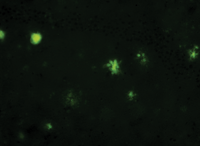Imagine differentially diagnosing Alzheimer’s and other neurodegenerative diseases with just an eye exam and simple eye drops or ointment.

Fluorescent probes, visible with ordinary ophthalmic equipment, glow different colors depending on the type of neuro disease. Here, the diagnostic probes glow green when bound to amyloid associated with Alzheimer’s disease.
That’s the hope of scientists at the University of California, San Diego, who have devised several new fluorescent probes that identify different, though related, degenerative brain diseases, including Alzheimer’s, Parkinson’s and Creutzfeldt-Jakob.
The symptoms of these disorders overlap, and methods to diagnose and monitor them are not very specific. But one property they have in common is the accumulation of amyloid plaques. So the researchers developed fluorescent probes that attach themselves to these amyloids.
The probe’s color varies depending on the physical properties of the different amyloid proteins. The team demonstrated that one of their probes glows yellow when marking amyloid deposits associated with prion disease, but it glows green when it binds to amyloids associated with Alzheimer’s disease.
“The key trick here is that the small differences in the proteins that make up different forms of amyloid interact differently with our fluorescent probes to result in measurably different colors of the emitted light,” says Jerry Yang, Ph.D., one of the project’s leaders and a professor of chemistry and biochemistry at UC San Diego. “The approach has the potential to help distinguish disease progression for a number of amyloidogenic neurological disorders.”
Because amyloids accumulate in the eye as well as the brain, this discovery offers hope that neurodegenerative diseases could be differentially diagnosed using only eye drops and ordinary exam equipment.
“The molecules were designed to conform to standard ophthalmic instruments that are widely available,” Dr. Yang says. “Although for our detailed studies we used a microscope that is commonly limited to research use due to cost, a key feature in the design of our probes is that they have the potential to light up in a window of light that can be viewed by common instruments available in hospitals, clinics and optometrists’ offices.”
Currently, there is no single test that diagnoses Alzheimer’s. Doctors typically run a battery of neurophysiologic tests as well as brain scans to detect signs of the disease. Using the fluorescent markers offers a lower cost, more accessible and safer alternative to brain imaging, the researchers say.
“There are many other amyloidogenic disorders (most related to neurodegeneration but not all), and we are seeking to develop methods to distinguish as many of them as possible,” Dr. Yang says. “The research is ongoing, and we hope to be able to report our finding soon.”
Meanwhile, the technology has been licensed for commercial development of diagnostic tests for human neural disease.

